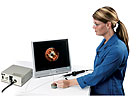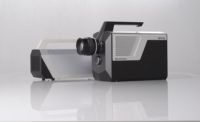
A rigid borescope with video camera inspects engine valves. Source: Gradient Lens Corp.
To improve the quality of visual inspections of hard-to-reach areas such as deep bores or complex castings, borescope video inspection is an effective answer. Borescopes are optical instruments, akin to medical endoscopes, that allow operators to inspect products or components that they cannot inspect via other means. The result of attaching a video system to a borescope not only improves quality control, but also streamlines research and development (R&D) processes and improves workplace ergonomics for inspection personnel.
The use of borescope video inspection is growing for a number of reasons. First, companies’ technological sophistication around digital imagery has grown by leaps and bounds, led by the widespread use of digital cameras with PCs. Next, video capture cards and USB converters for painless image transfer from camera to PC are readily available today. Finally, ubiquitous e-mail has made video-image dissemination easy and lightning-quick.
The metal-machining, casting, welding and molding industries all use borescopes and borescope video inspection to inspect components at the manufacturing level and in other key areas. Borescope video inspectors are usually personnel in quality assurance and control and R&D, plant machine operators and mechanics.
Borescopes come in a variety of models and diameters. Flexible borescopes are ideal for inspecting complex parts and castings where the view is not straight ahead. Tiny semi-rigid borescopes can examine very small parts and openings not accessible to the naked eye.
Rigid borescopes offer the highest resolution and brightest images and are more durable and more economical. If the part can be inspected with a rigid borescope, it may be the best investment. Rigid borescopes are ideal when the area to be inspected is reachable via a straight path, as in many machined parts, tubing and some molded parts. The borescope’s direction-of-view, however, can be 0, 30, or 70 degrees, and, with a mirror tube adaptor, 90 degrees. Additionally, a scope featuring a continuous-range swing prism at its tip delivers directions-of-view over a range of 16 to 118 degrees.
A convenient way to capture video images from a borescope is to use a video capture system that is interchangeable with any borescope, no matter the size or manufacturer. Borescopes range in price from $600 to $12,000 and video capture systems in the $3,500 to $5,000 range.
The typical system setup is straightforward: a borescope, video coupler, video camera, light source with light guide, and a monitor or PC for viewing. Operators can save the video or still images to a computer. If they want to capture and store images to a desktop or laptop computer, they will need an internal video capture card, or an external USB converter. They can save any still or video image they acquire through a video camera on the PC or laptop hard drive and then e-mail or burn them to disk.
Though most industry operators are capturing still video images, capturing full-motion video footage also is possible when they want to document an entire inspection or show the motion of a particular component or part.

Inspection of an electrical connector with a 0.09-millimeter diameter flexible borescope is displayed on a video monitor. Source: Gradient Lens Corp.
They can receive instantaneous nondestructive QC and manufacturing feedback on the manufacturing process, allowing them to fix any problems as soon as someone detects them-even while the job is still on the line.
It can improve the comfort of operators, even in groups, who are doing visual inspection, giving them the benefit of viewing images on a monitor instead of having to look through the eyepiece of a borescope for hours on end.
Operators can expand the benefits of borescope video inspection through specialized software on the market. For instance, software is available that allows operators to establish and maintain QC standards and procedures, document borescope inspections and accomplish several other key tasks. By defining a series of annotated reference images to display along with the live image during inspection of each feature of a part, operators can classify, capture and display a series of reference or go/no-go images to compare with live images. If they find a problem, it is easy to capture and annotate the image and save it to a QC archive.
Software can be used to share images with vendors, customers, regulators, or internal manufacturing and engineering teams. In addition, software can help train new personnel.
For those who think that still cameras are cheaper than video-capture systems and, arguably easier to use, consider the advantages offered by viewing live video during the inspection and discussing the images with a group. The distinction between video and still digital cameras is becoming blurred, however, as more and more still cameras offer video capability and vice versa.


